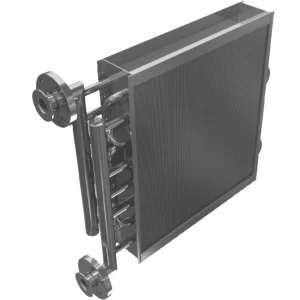FINS AND TUBES HEAT EXCHANGER
CONSTRUCTION
STAGGERED CONFIGURATION
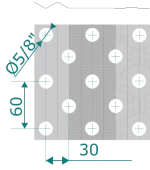
| Tubes Material | Cu, Cu,Ni, Fe, AISI 304, AISI 316, Titanium |
|---|
| Fins Material | Al, AlMg2.5m, AlEpoxy, AlHy, Cu, AISI 304, AISI 316 |
| Observations | Fins pitch from 1.6 to 6.0 mm and fins thickness from 0.11 to 0.23 mm |
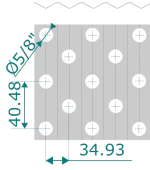
| Tubes Material | Cu, CuNi, Fe, AISI 304, AISI 316, Titanium |
|---|
| Fins Material | Al, AlMg2.5m, AlEpoxy, AlHy, Cu, AISI 304, AISI 316 |
| Observations | Fins pitch from 1.6 to 6.0 mm and fins thickness from 0.11 to 0.23 mm |
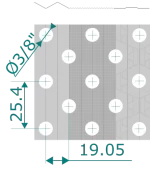
| Tubes Material | Cu, CuNi |
|---|
| Fins Material | Al, AlMg2.5m, Epoxy, Cu, AISI 304, AISI 316 |
| Observations | Fins pitch from 1.6 to 6.0 mm and fins thickness from 0.11 to 0.23 mm |
SQUARE CONFIGURATION
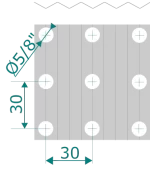
| Tubes Material | Cu, CuNi |
|---|
| Fins Material | Al, AlMg2.5m, AlEpoxy, AlHy, Cu, AISI 304, AISI 316 |
| Observations | Fins pitch from 1.6 to 8.0 mm and fins thickness from 0.11 to 0.23 mm |
The configuration is selected based on the working conditions of each project, providing solutions for air treatment, water treatment for industrial processes, refrigeration and air conditioning. As they are custom-made heat exchangers, they are ideal for replacements that have to be carried out by installers or maintenance technicians and are also ideal for new projects of technical offices and manufacturers of air conditioning equipment such as chillers or units of air treatment (UTAs).
Tube and fin exchangers are available in various finishes, from anti-corrosion treatments such as Blygold®, Heresite®, Electrofin®, Aqua Aero® or zinc-plated, to manifold connections with flanges, threaded tubes or plain tubes to be welded . Additionally we can incorporate fans, droplet separators, humidifiers, electric defrosting resistors, air-tight frames and pressurized casing.
INFORMATION TO REQUEST A FINS AND TUBES HEAT EXCHANGER
We can make an offer using two different methods.
1. In the first, we perform a thermodynamic calculation, this is used mainly for new projects or existing projects where you want to verify performance. To proceed we need you to select one of the following tabs depending on the type of exchanger desired and send us the data by email.
To size the water exchanger coil we need you to confirm 5 of the following values as well as the maximum available dimensions.
– Calorific capacity (kcal/h or kW)
– Air flow (m3/h)
– Air inlet temperature (ºC) and relative humidity (%)*
– Air outlet temperature (ºC) and relative humidity (%)
– Water flow (l/h or l/min.)
– Water inlet temperature (ºC)*
– Water outlet temperature (ºC)
– Maximum available sizes (length x height x depth)
To size the condenser we will need you to confirm 5 of the following values as well as the maximum available dimensions.
– Calorific capacity (kcal/h or kW)
– Air flow (m3/h)*
– Air inlet temperature (ºC)*
– Air outlet temperature (ºC)
– Refrigerant*
– Condensation temperature (ºC)*
– Maximum available sizes (length x height x depth)
To size the evaporator we will need you to confirm 5 of the following values as well as the maximum available dimensions.
– Calorific capacity (kcal/h or kW)
– Air flow (m3/h) *
– Air inlet temperature (ºC) and relative humidity (%)
– Air outlet temperature (ºC) and relative humidity (%)
– Refrigerant *
– Evaporation temperature (ºC) *
– Maximum available dimensions (length x height x depth)
To size the steam battery we will need you to confirm 4 of the following values as well as the maximum available dimensions.
– Calorific capacity (kcal/h or kW)
– Air flow (m3/h)
– Air inlet temperature (ºC)
– Air outlet temperature (ºC)
– Steam pressure (Kg/cm2 atm. or bar)*
– Maximum available dimensions (length x height x depth)
2. In the second, we start from the existing sizes, for this reason, if what you want is a replacement of the current equipment this may be the most practical system. You can send us a simple plan and a photo to our technical office.

